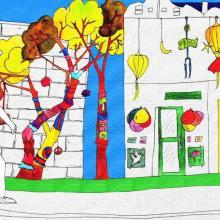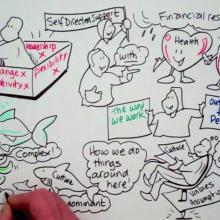This storyboard (animated video) aims to explain what action research is and how it can help to improve public services. It uses the example of Cedar (Children experiencing domestic abuse recovery) to talk through how action research can be useful and offers some hints and tips for those thinking about undertaking action research themselves.
The storyboard was written and narrated by Cathy Sharp (Research for Real) with support from Iriss. Animation by graham@ogilviedesign.co.uk
The issues in this storyboard are explored further in an article When are you ever not piloting? by Cathy Sharp from Research for Real.
Further information and resources are available about:
Iriss and Research for Real
How action research can help to deliver better services
Action research is a participatory process of learning in action, which generates and tests living, practical knowledge.Here we reflect on how this is different from the usual ways we research people and organisations and why it particularly matters now that we learn about what it offers because of the challenges faced by public services and communities.
We're using the example of Cedar to learn more about action research. Cedar stands for 'children experiencing domestic abuse recovery'.It's a good example of a publically-funded project which has a lot of features in common with other projects.We expect that this will be of interest to a wide range of people - both 'doers' and'thinkers' (or perhaps a bit of both) -in fact, anyone who has an interest in both impact and implementation of public policy.
Across the UK, organisations that provide services to the public are increasingly talking about changing the way that things are done. In Scotland, it's been suggested that the solutions to many of our problems lie in doing things that will help much earlier on, so that they are nipped in the bud (so to speak) and save money in the longer term.So, for example, working much sooner with children who have been affected by domestic abuse doesn't stop the fact of that abuse, but it might help them to deal with their feelings about it. And that might mean that some of the kind of problems, such as mental health problems are prevented from happening in the future
This is exactly what the Cedar programme set out to do. It's a twelve week programme that brings children and young people together with others of the same age to learn that domestic abuse is not their fault and to learn from each other.It helps children learn how to stay safe and to talk to their Mothers about their feelings. [separate small groups of Mums and children, 3 adults (2 women, one man) with children, 2 (both women) with mothers]
Cedar came from Canada originally, with good credentials.But still we didn't know for sure that what had worked well in Canada would work in Scotland.So, Scottish Women's Aid persuaded the Scottish Government to provide money to fund a pilot project.That's what we call projects when we are not 100% sure that they will work and want to test them out before we 'roll them out' to more places.
In situations like this it's a good time to .As well as providing evidence of outcomes to show whether or not the programme achieves its goals, action research can help you to ask 'what shall we do?' type questions or other questions about how a new idea or approach might actually work, in the conditions that you face.So, it's useful in any situation where you want a shared and well-grounded understanding of whether, how and why things happen and what might happen differently. That shared or 'together' bit is important because no single person or organisation is likely to have 'an answer' - lots of people might have a part of one, at least for the time being.
By working together in this way, it might be possible to find new solutions to problems for individuals and change the way that organisations respond.
Let's walk through the action research cycle to show you what this means.
First, find an issue that matters to people, where there is a strong impetus to improve things and people are interested in change. It's best to start at the very earliest stages of thinking about an idea, project or problem.
Then, work out who you think has some kind of 'stake' in the issues:find some enthusiasts and work with them for starters. In the jargon, we call these people the 'stakeholders'.It's not always obvious who they should be, so be prepared to revise your initial view and to bring more people into the process as it develops.
Talk to your stakeholders and make sure that everyone that needs to be included gets a chance to give their views and talk about how they view 'the problem or issue'. Take time so that you find out the right questions you need to be asking, rather than the answers to your first questions.
Of course, there are lots of ways you might actually get their views which don't differ very much from conventional research.Try to use methods that encourage open-minded thinking, questioning of assumptions and conversation.
Once you've got a sense of how people understand the issues, it's possible to think about 'so what?' and 'now what?' types of questions.These really get at the implications of what you've heard and the next steps or actions that follow on in order to improve things.This kind of making-sense process or analysis is also best done collectively.
It's not always possible or desirable for everyone that has an interest in something to get together with everyone else and take part in discussions on an equal footing
It's at the point of thinking about implications for action that action research really is quite different, because rather than writing these up as 'recommendations', in action research we actually try them out to see how they work in practice.
So as an example, in the Cedar work, it was really important to hear from the children and mothers:we interviewed some of them in their homes and heard their views and ideas for making Cedar a better programme.This information was fed into a meeting of a local advisory group - that's people who were running Cedar or were interested in it because it was connected to their own work.
The local advisory group called it a 'reality check' - they were pleased to get this feedback - partly because it told them they were doing a good job and achieving the kind of outcomes expected.It's worth saying that people in public services do not always get that kind of praise - so, that was important. But they also heard about a few things that they
They had a few ideas of their own - of course - and some of the other staff not at the meetings had answered an on-line survey so we had their views too. This mix of views, ideas and expertise helped the advisory group to notice things afresh and develop a sense of what was important to keep doing and agree what they might try differently during the next cycle. This might be a very specific and immediate 'action point' such as inviting someone along from education to encourage more referrals from schools, or resolving to pay more attention to how co-facilitators manage group dynamics.
The action research cycle is a process of:
- really hearing what others are saying;
- noticing things yourself;
- coming together to share, make sense of things and reflect;
- thinking or reading about what might work;
- making a judgement about what to do next; and
- making plans to continue the 'experiment' and move into the next round of the cycle.
Of course, the questions don't really ever go away.By adopting this approach, of learning from experience in a deliberate and routine way, you learn to keep asking questions and test-out the new answers to move you closer to achieving the types of success that you want to see.
In fact, in Cedar there were three local advisory groups in different areas of Scotland.So over the course of the programme, we brought them together at larger events where we talked to each other in more depth, about what we thought we ought to be doing.
We did alot of story sharing and analysis.We looked at the statistics and asked questions about whether the programme was worth the money it was costing.We made recommendations which we sent to the Scottish Government, based on what we were already doing because we had tested it out and found out what was effective.
The last event of this kind, involved some 'Cedar Graduates' - young people and mothers who had completed a Cedar group.They were very clear about what mattered to them and helped to make sure that our conclusions were really well grounded in the real world.
Let's finish by going back to where we started talking about doing things differently.This way of working is certainly not 'usual business' for people who work in public services or for those that use them. All this sharing of ideas and experience helps people to see things in new ways and to learn things that have immediate practical relevance for them.
Cedar and other examples show that it is possible to create an appetite for evidence because it is seen as directly relevant to daily problems. There are lots of different ways of doing this - I hope this example gives you a good sense of some of the principles of the approach with the emphasis on dialogue, collaboration, purpose and values, and action.
It makes research an approach to learning and yes, sometimes, 'unlearning', that recognises that people learn best from 'doing', from trying things out and reflecting on the effects they create. They do this best in collaboration with others who have a perspective to offer and a stake in the outcomes.
This kind of action rooted, inquiry-led process can breathe life into the work we do - it creates space and time to talk to each other, ask good questions, to work across the boundaries between organisations and become better at joint efforts to achieve change.
So, in that spirit, we invite you to give it a try. Use Cedar as an inspiration, rather than a template. Space here doesn't permit a full list of hints and tips, but our top five are:
- Create the right climate from the start. Commit to and protect time out from routine activities for reflection. Talk about your values and purpose and about the assumptions you are making, so you can revise them where you need to.
- Treat your efforts as a pilot, experiment or some other term that conveys your openness to alternative ways of thinking, choices and actions and crucially, gives you a space to try out new actions.
- Get a clear and strong commitment to the process from senior managers so that it can help both individual staff and the organisation as a whole to learn what needs to be done differently.
- Value the stories that people tell. Encourage them and find ways to make the telling, sharing and analysis of experience a routine part of the work. Make sense of them together and don't dismiss an isolated episode as 'anecdotal'. Notice and explore the puzzles, paradoxes and tensions that arise.
- Always think about what voices are missing - find ways to bring in other perspectives and ways to check out different views of 'reality'. Link local inquiries up wherever possible to illustrate wider lessons and insights.
Oh yes, and share your experience so that others can learn too!
This storyboard was written and narrated by Cathy Sharp (Research for Real) with support from Claire Lightowler and Lisa Pattoni (Iriss). Animation by Graham@olgilviedesign.co.uk.
July 2012



